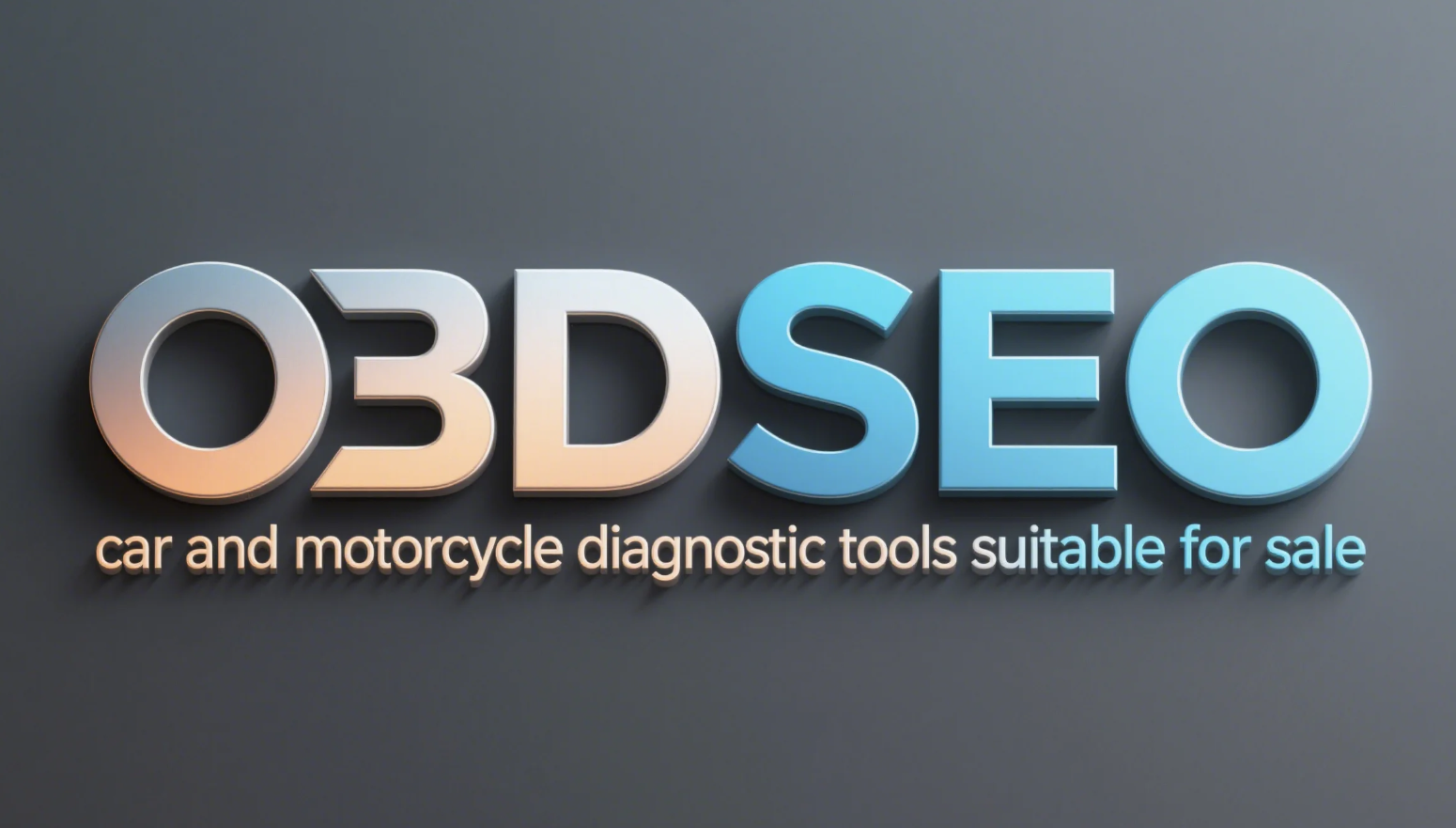OBDSEO: Bluetooth Motorcycle Diagnostic Scanners: The Ultimate Guide

The landscape of motorcycle maintenance has been transformed by wireless technology, with Bluetooth diagnostic scanners leading this revolution. These innovative tools have eliminated cumbersome cables, enhanced mobility around the vehicle, and leveraged the power of smartphones and tablets to create more accessible and powerful diagnostic solutions. This comprehensive guide explores everything you need to know about Bluetooth motorcycle diagnostic technology, from basic principles to advanced applications.
Understanding Bluetooth Diagnostic Technology
Bluetooth technology enables wireless communication between your diagnostic adapter and display device through radio frequency transmission. This standardized protocol allows for secure, short-range data exchange that’s ideal for motorcycle diagnostic applications. The technology operates in the 2.4GHz frequency band, using sophisticated frequency-hopping spread spectrum techniques to minimize interference from other wireless devices.
The pairing process typically begins with placing the Bluetooth adapter into discovery mode, then initiating a connection from your smartphone, tablet, or computer. Once paired, the devices establish a secure connection that allows diagnostic data to flow between your motorcycle’s electronic control units and your display device. Most modern adapters use Bluetooth 4.0 or newer, offering improved power efficiency and data transfer rates compared to older standards.
Data transmission security has improved significantly in recent Bluetooth implementations, with encryption protocols protecting sensitive vehicle information. This security is particularly important when accessing critical systems like engine management or ABS. Reliability has likewise advanced, with modern Bluetooth connections maintaining stable connections even in challenging workshop environments.
Range limitations typically restrict Bluetooth diagnostic connections to approximately 30 feet (10 meters), though actual performance varies based on environmental factors and specific adapter capabilities. This range proves sufficient for most diagnostic scenarios but may present challenges for some applications like real-time monitoring during test rides.
Advantages of Wireless Diagnostic Solutions
Mobility and convenience represent the most immediate benefits of Bluetooth diagnostic tools. Technicians can position themselves optimally around the motorcycle while maintaining connection to their diagnostic display, eliminating the awkward cable management issues common with traditional scanners. This freedom of movement proves particularly valuable when diagnosing issues that require simultaneous observation and testing.
Smartphone and tablet integration transforms devices you already own into sophisticated diagnostic displays, leveraging their processing power, high-resolution screens, and intuitive touch interfaces. This approach reduces the need for dedicated hardware, potentially lowering the entry cost for quality diagnostics while providing superior user experiences compared to many standalone units.
Real-time data monitoring while riding represents a unique capability of wireless diagnostic systems. With proper mounting and safety considerations, Bluetooth adapters can transmit live data to a smartphone mounted on the handlebars, enabling performance monitoring and troubleshooting of intermittent issues that only occur under specific riding conditions.
Space-saving benefits make Bluetooth diagnostic tools particularly attractive for home mechanics with limited workshop space. Wireless adapters eliminate cable clutter and typically feature more compact designs than traditional scanners, making storage simpler and workspaces more efficient.
Leading Bluetooth Motorcycle Diagnostic Options
Universal Bluetooth OBD adapters offer broad compatibility across multiple motorcycle brands, though with varying depths of functionality. These versatile tools typically connect to standard OBD ports and communicate with smartphone apps designed for multi-brand diagnostics. Quality and capabilities vary significantly in this category, from basic code readers to sophisticated devices offering advanced functions.
Brand-specific wireless diagnostic tools focus on particular manufacturers, trading broad compatibility for deeper functionality with specific motorcycles. These specialized adapters often access proprietary systems and functions unavailable to universal tools, making them valuable for enthusiasts dedicated to particular brands like Honda, Harley, or BMW.
Professional-grade Bluetooth diagnostic platforms combine wireless convenience with advanced capabilities approaching dealer-level equipment. These sophisticated systems typically include high-quality wireless adapters paired with professional software for tablets or laptops. While more expensive than consumer options, they offer capabilities suitable for independent shops and serious enthusiasts.
Budget-friendly options have proliferated as Bluetooth technology has matured, with several manufacturers offering affordable wireless adapters under $100. These entry-level tools typically provide basic code reading and some live data functions, making them accessible starting points for casual users seeking basic diagnostic capabilities without significant investment.
Brand Compatibility Considerations
Honda’s Bluetooth diagnostic compatibility has improved significantly, with several quality wireless adapters now offering good support for the Japanese manufacturer’s systems. Most modern Honda motorcycles work well with universal OBD adapters, though some advanced functions may require more specialized equipment. The widespread popularity of Honda has encouraged the development of numerous compatible apps with model-specific features.
Harley-Davidson wireless diagnostic options have expanded beyond dealer tools, with several aftermarket manufacturers now offering Bluetooth solutions for the American brand. These range from basic adapters for code reading to more sophisticated systems that access proprietary functions. The unique nature of Harley’s systems means compatibility research is particularly important before purchasing.
BMW’s advanced Bluetooth diagnostic protocols reflect the sophisticated electronics in modern BMW motorcycles. The German manufacturer’s complex systems often require specialized adapters or software to access fully, though several high-quality wireless options now exist. BMW enthusiasts should verify specific model compatibility, as the brand’s electronic architecture has evolved significantly across generations.
Kawasaki, Yamaha, and Ducati wireless support varies by model and year. Japanese manufacturers Kawasaki and Yamaha generally work well with quality universal adapters, while Italian brand Ducati sometimes requires more specialized solutions, particularly for accessing performance-oriented systems and advanced features.
Suzuki Bluetooth diagnostic solutions parallel other Japanese brands, with good support from universal wireless adapters. Most quality Bluetooth tools provide reasonable Suzuki coverage, though as with all brands, newer models with advanced electronic systems may require more specialized equipment or updated software.
Smartphone Applications for Motorcycle Diagnostics
iOS versus Android app comparison reveals strengths in both ecosystems. Apple’s iOS typically offers more polished interfaces and stricter quality control, while Android provides greater customization and sometimes more advanced technical capabilities. Most major diagnostic apps support both platforms, though feature parity isn’t guaranteed across operating systems.
Free versus premium app features present important considerations for budget-conscious users. Free apps typically offer basic code reading and some live data functions, while premium versions add advanced capabilities like custom gauge layouts, enhanced data logging, and specialized testing functions. The cost-benefit analysis varies based on your specific needs and motorcycle systems.
User interface and ease of use vary dramatically between apps, from simplistic code readers to sophisticated platforms with customizable dashboards and comprehensive help systems. The best applications balance power with accessibility, providing intuitive navigation while maintaining advanced capabilities for experienced users.
Data logging and sharing capabilities enable recording diagnostic information for later analysis or consultation with other mechanics. Premium apps typically offer more sophisticated logging with higher sampling rates, more parameters, and better export options. These features prove particularly valuable for diagnosing intermittent issues or tracking changes over time.
Advanced Features Through Bluetooth Connectivity
ABS system access through wireless connection has become increasingly common as diagnostic apps have matured. Quality Bluetooth tools can now read ABS fault codes, monitor sensor data, and in some cases, perform basic actuation tests. More advanced functions like bleeding procedures typically remain limited to professional-grade wireless systems.
OBD and OBDII protocol support over Bluetooth has standardized considerably, with most quality adapters now supporting multiple protocols including CAN, ISO, and KWP2000. This multi-protocol support enhances compatibility across different motorcycle brands and model years, though manufacturer-specific implementations still create some compatibility challenges.
Real-time performance monitoring represents one of the most valuable applications of wireless diagnostics, enabling observation of multiple parameters simultaneously through customizable gauge layouts. This capability proves invaluable for tuning, troubleshooting, and performance optimization, providing insights impossible through traditional methods.
Custom mapping and tuning possibilities have expanded with advanced Bluetooth diagnostic platforms that include reflashing capabilities. These sophisticated systems can modify engine management parameters to optimize performance, address manufacturer programming issues, or accommodate aftermarket components. Such capabilities require technical knowledge to use safely and may have warranty implications.
Troubleshooting Bluetooth Connection Issues
Common pairing problems typically stem from either incorrect procedures or device compatibility issues. Always follow the exact sequence specified by the manufacturer—typically this involves putting the adapter in discovery mode before attempting to pair with your device. For persistent pairing failures, try clearing all previous Bluetooth connections from both devices before attempting to establish a new connection.
Signal interference issues frequently arise in environments with multiple wireless devices or electromagnetic sources. Bluetooth operates in the crowded 2.4GHz spectrum, making it vulnerable to interference from WiFi networks, microwave ovens, and other electronic devices. When experiencing intermittent connections, try moving away from potential interference sources or switching to a different location.
Battery drain considerations become important during extended diagnostic sessions, particularly when using mobile devices as displays. Bluetooth adapters vary significantly in power consumption, with some drawing power directly from the motorcycle while others incorporate internal batteries. For lengthy procedures, consider connecting your display device to a power source to prevent interruptions.
Firmware update procedures require careful attention to maintain stable connections throughout the process. Always ensure both the adapter and the connected device have sufficient battery charge before beginning updates. If possible, disable power-saving features that might interrupt the connection during the update process. For critical updates, consider performing the procedure in an environment with minimal wireless interference.
Where to Find Quality Bluetooth Diagnostic Tools
Specialized motorcycle shops often provide better technical guidance and after-sale support than general retailers, with staff who understand the specific requirements of motorcycle diagnostics. These specialized vendors frequently have practical experience with the tools they sell, providing valuable insights into real-world performance and suitability for specific motorcycle brands.
Amazon and other online marketplaces offer convenience and often competitive pricing, though require careful research to avoid counterfeit or substandard products. Look for listings with detailed specifications, clear compatibility information, and substantial verified customer reviews. Manufacturer-direct listings or those fulfilled by Amazon typically provide greater assurance of authenticity.
Price comparison strategies should consider the total package rather than just the adapter cost. Some manufacturers offer seemingly inexpensive hardware but require expensive app purchases or subscriptions to unlock full functionality. Calculate the complete cost including any required software or subscriptions before making purchasing decisions.
Bundle deals with software subscriptions can provide excellent value, particularly for professional-grade systems that receive regular updates. These packages typically include the wireless adapter, premium app access, and update subscriptions for a specified period. For active users, these bundles often represent better value than purchasing components separately.
Warranty and support considerations should factor heavily in your purchasing decision. Quality manufacturers stand behind their products with meaningful warranties and responsive technical support. Research the manufacturer’s reputation for after-sale support before committing to their ecosystem, as diagnostic tools often require occasional technical assistance.
The Future of Wireless Motorcycle Diagnostics
The Bluetooth revolution in motorcycle diagnostics continues to advance, with increasing integration between diagnostic systems, rider aids, and connected vehicle technologies. Future developments will likely include enhanced real-time monitoring, predictive maintenance capabilities, and deeper integration with manufacturer service systems.
For most users, wireless diagnostic tools now represent the optimal choice, combining convenience with increasingly sophisticated capabilities. The best wireless diagnostic tool for your specific needs depends on your technical comfort level, the motorcycles you maintain, and your budget constraints. By carefully assessing these factors against the capabilities and limitations of available tools, you can make an informed investment that enhances your maintenance capabilities.
Investment considerations should include not just initial purchase price but also long-term support, update availability, and expandability. Quality Bluetooth diagnostic tools from established manufacturers typically offer better longevity and value despite sometimes higher initial costs.
The debate between wireless and wired diagnostics has largely been settled in favor of Bluetooth for most applications, with the convenience and flexibility of wireless connections outweighing the marginal reliability advantages of wired alternatives. Modern Bluetooth implementations have largely overcome the stability and security concerns of earlier generations, making wireless the preferred c (Content truncated due to size limit. Use line ranges to read in chunks). For more, visit https://www.obdseo.com





